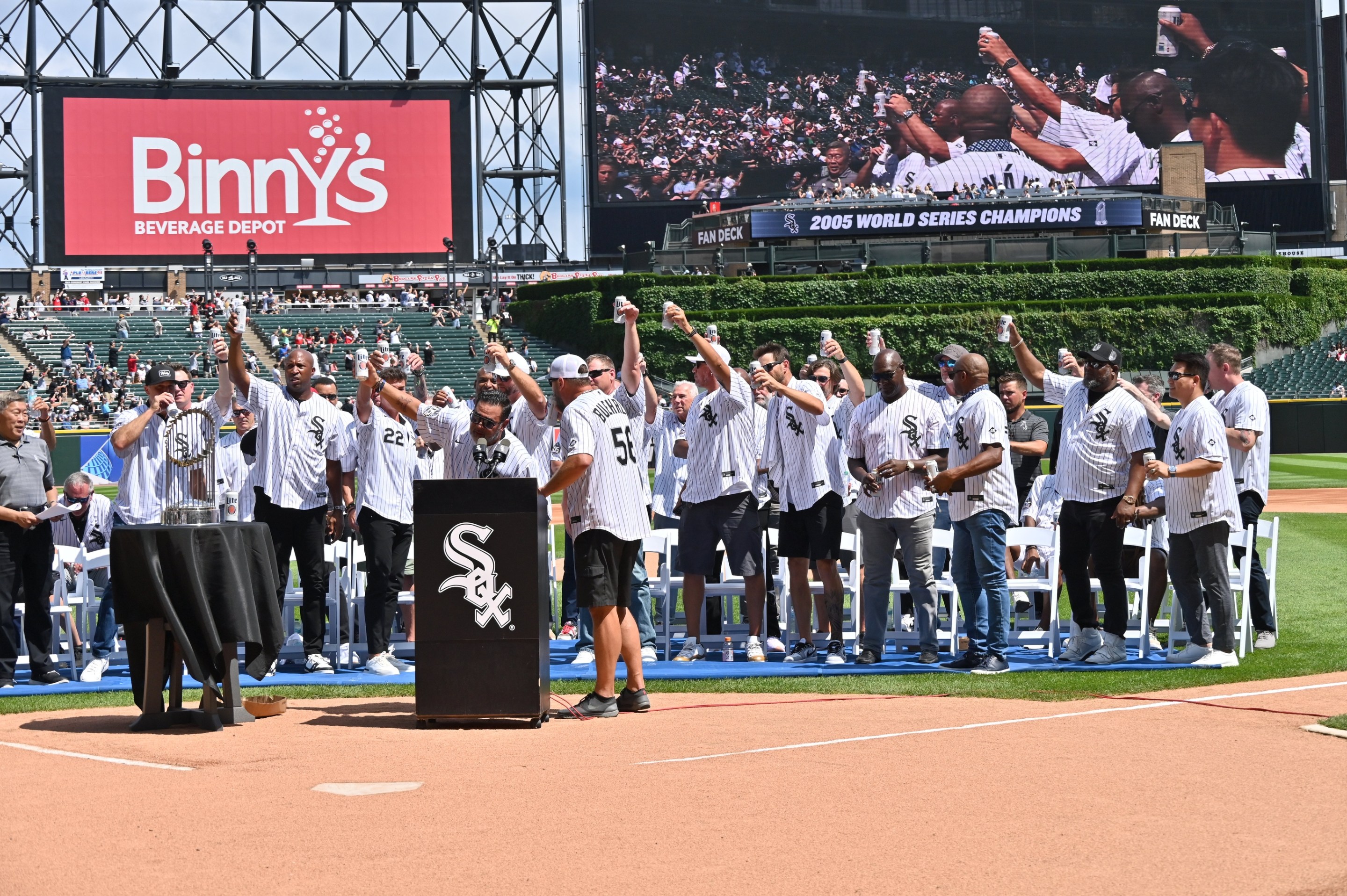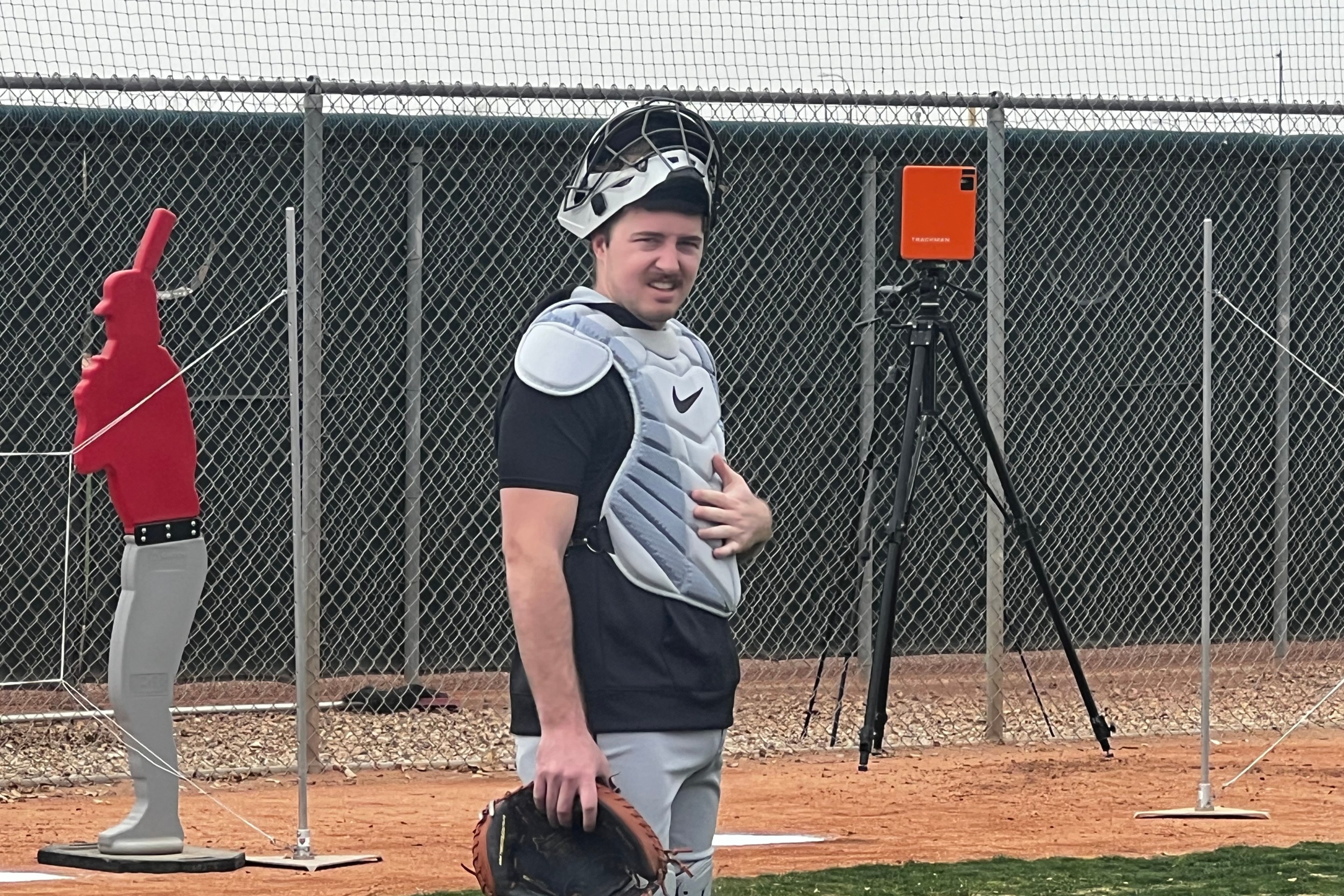The 2005 World Champion White Sox are reunited this weekend, but without the late Bobby Jenks, their elite closer whose sudden and undeniable emergence represented the phenomenon that was this team as much as anyone, but is now dead from stomach cancer after just 44 years on Earth.
The weight of his absence makes it hard to determine what sort of gesture is enough.
"When we found out, I was at a loss for words," said Joe Crede.
"It's just an awful situation," said A.J. Pierzynski.
As the assembled members of the 2005 roster posed behind the Rate Field mound for a team photo on Saturday, they held Jenks' jersey up front and center, placing the gregarious closer right in the middle of all the men who dogpiled on top of him 20 years ago this October. Mark Buehrle pulled out a full tray of Miller Lite beers and initiated a toast to his old teammate, of which many fans in attendance were happy to take part. In recent days, White Sox stadium operations has taken to letting Jenks' old entrance song "Here Comes the Boom" play out in full, just to let the familiar sound signaling the right-hander's arrival rattle around the stadium, vibrating into our bones.
"You can say it's the worst thing," Paul Konerko said. "But if it happened, maybe it's the best thing, because we had a chance for everybody to think about him all day."
"I just talked to him on the 1st, and we had a great conversation," said Toby Hall, through tears. "He said, 'I want you to stand and represent me with my wife and kids.'"
The unifying theme of all these gestures feel clear: It's all trying to recreate and reconnect to what Bobby Jenks made people feel, whatever that happened to be.
"A great guy that loved to joke around, smiled a lot," said Jermaine Dye. "I would come behind him and he did not like to be tickled or touched, so I used to tickle him a lot. You know, he used to play with my kids when they were young. That's just Bobby."
And we might as well all share what Jenks' tragic passing brought to mind for us, and since Josh sprung it on me on the podcast, it's only been kicking around in my mind more.
⚙️⚙️⚙️
I worked as an overnight summer camp counselor in Michigan after graduating high school in 2005, so I kept up with the middle portion of the White Sox season via newspaper clippings that my mother sent me in the mail. From the time Jenks emerged into my awareness via a minor league update at the bottom of a Mark Gonzales notebook, all through his midseason emergence as a ready-made dominant closer, his attributes -- 100 mph fastball, overpowering curveball and slider, and imposing 6'4", 275 pounds -- felt like something out of a tall tale, something would sound embellished if you couldn't see it yourself.
"With Bobby, it's like I almost didn't need a glove. I could just stand there and watch him strike everybody out," Crede said.
"He was power pitching before it became what it is today," Pierzynski said. "If you had the radar guns they have today, he might be 105 mph, because it was a heavy 100 mph."
As I still find happening often with the game now, Jenks' dominance just made me more curious about how it all worked. The swings Jenks got on fastballs above the letters were just as confounding to the novice viewer as a hitter chasing breaking balls in the dirt -- representative of some phenomenon hard to understand from the outside.
"Bobby was again ahead of his time for what he was featuring back then," Konerko said. "If you watch footage from back then, not just us, but any games, a lot of things stick out like, ‘Wow, that doesn’t look like today.’ The stuff, although I think [radar] guns might be different. Even the size of the player, the speed of the player, it’s always bigger, stronger, faster. Bobby is one of those guys you could have picked up in 2004, '05, '06 and dropped him into this game today and he fits right away."
In something that happens more than is publicized, a visual observation Hawk Harrelson made at the time of Jenks' emergence wound up dovetailing with what research data would bear out later as objectively true. As reliably as announcers in that era would trumpet the necessity of pitching low in the zone and inducing ground balls, Harrelson was quick to identify Jenks as having a fastball he'd be better off elevating, and that hitters being able to drop the bat head on pitches low in the zone was the only way they could keep pace with such velocity. It was a break from the espoused orthodoxy of the time, though the White Sox were already open to high fastballs.
"Don Cooper just told us that you've got to be able to throw strikes, but you've got to be able to throw strikes all over the zone," said Cliff Pollitte. "Because once you live in a spot for so long, a good hitter will make an adjustment, so we had to change eye levels."
After I joined the White Sox beat in 2017, Cooper would often poke fun at me for being agog over the modern trend of using pitch-tracking data to uncover that high-spin fastballs frequently work best when utilizing their carry up in the zone, because he had been instructing pitchers to use high heaters as two-strike putaway pitches for years prior. And to his point, a decade before Danny Farquhar was at his locker introducing me to all the numbers the Rays showed him that explained why a carrying four-seamer tunneled so well visually with an over-the-top curveball, Jenks had been demonstrating the same effect against a totally different era of hitters.
"He was kind of an anomaly with how hard he threw, and his breaking ball was super hard and good," said Neal Cotts.
"It was almost alien how hard he threw and with his curve, that was the thing," Konerko said. "No one had seen that type of mix, I don’t think."
At a time where the sport is perceived to be changing rapidly, and in response to statistical data more so than observed experience, it's striking to look back upon and rewatch the phenomenon that Jenks was on the mound, and see his talent and fearlessness leading him to pitch in a style that 20 years of advancement in both research and physical training leads the game to now resemble. Jenks is gone, but there are still traces of him in this game that he loved, even in something as minute as an initiative the White Sox were pushing with their early-count catching setups this spring.
"I remember with him, I used to just set up in the middle and tell him just throw it as hard as you can, and he would do that" Pierzynski said. "If you watch the game now, especially with relievers, all the catchers set up in the middle even with a lot of the starters, and just deal with where the zone is."
⚙️⚙️⚙️
Remembering Jenks as an origin story for appreciating a good vertically oriented pitching arsenal is not the most sentimental way of appreciating a man who contained so many multitudes. There were more touching testimonies of Jenks as a gentle giant shared this weekend on the South Side. But those are from his friends and loved ones, who have deeper reasonings for wanting his legacy to be appreciated.
"We just started talking and he goes, ‘Toby, I’m not scared anymore,'" Hall said, recalling their last conversation. "When he said he wasn’t scared anymore, and I knew he didn’t want to watch all this in Portugal. And he got one of the best seats today. He got one of the best seats to watch all of us and his family. "
But part of appreciating a man like Jenks, a team like the 2005 White Sox, and the experience of enjoying them alongside thousands of strangers, is knowing that all of sharing our connection to it only serves to make it more meaningful. Bobby Jenks was special, and should not be forgotten. For that, we all have a part to play.
"You never die when people will remember you every day, every time," Guillen said. "You never die, you just left."






